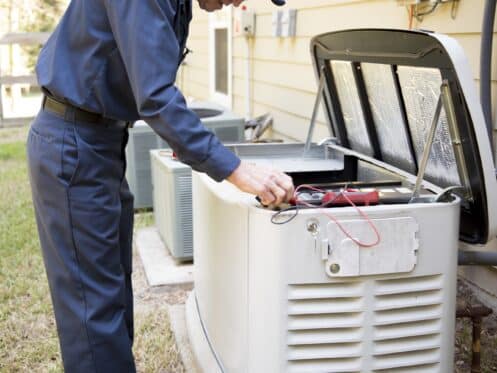Power outages can occur as short, transient faults or last for an extended period. Power outages are inconvenient. They often have far-reaching implications. Loss of electricity can disrupt communication systems, transportation and critical public health infrastructure. Extended power outages can lead to significant losses and operational challenges for businesses. Understanding the most common causes of power outages can help us better prepare and respond to these challenges. They include:
1. Natural Disasters
Natural disasters are a key contributor to power outages and can cause extensive damage to the electricity infrastructure. These can range from severe weather events, such as thunderstorms, hurricanes and blizzards, to geological events, like earthquakes or landslides.
Severe Weather Events
Severe weather events often involve high winds, which can knock down power lines, heavy rain that can flood substations or heavy snow and ice that can weigh down and break power lines and trees. Lightning strikes during thunderstorms can directly hit the grid or cause fires that damage electricity infrastructure. Hurricanes, known for their violent winds and heavy rain, can wreak havoc on power lines, substations and power plants.
Geological Events
Geological events, like earthquakes, can damage power generation facilities and substations, disrupt underground cables and cause landslides that take down overhead lines. Earthquakes can also trigger tsunamis, leading to flooding that further disrupts the power supply. It’s worth noting that the impact of these natural disasters can be widespread, causing power outages that affect millions of people and last for several days or even weeks.
2. Human Error
Human error is another significant contributor to power outages. Despite the best efforts to automate and safeguard the electric grid, it remains vulnerable to human mistakes. These errors can occur at various levels — from the operation of power generation facilities to the maintenance of the distribution grid.
Mistakes in Operation
Operational mistakes are often the result of misunderstanding, negligence or lack of training. An operator at a power plant may accidentally shut down key equipment, or a technician may mishandle sensitive devices, causing a short circuit. These errors can lead to power outages at the facility level, affecting the power supply to connected areas.
Errors in Maintenance
Maintenance errors typically occur when performing routine service tasks incorrectly. Maintenance errors could include failing to replace aging equipment, improperly installing hardware or not addressing known faults in the system. This error can lead to equipment failures that result in localized power outages.
Accidental Damage
Human error can also result from accidental damage to the electricity infrastructure. For example, construction crews digging without proper clearances can inadvertently damage underground power cables. This accidental damage can cause sudden power outages and require extensive repairs.
3. Mechanical Problems
Mechanical problems contribute significantly to power outages. These problems arise from the failure of physical components within the power generation, transmission or distribution system.
Equipment Failure
Equipment failure is a common cause of mechanical problems. It includes malfunctioning transformers, circuit breakers, transmission lines and generators. Age, wear and tear, poor maintenance and manufacturing defects can all lead to equipment failure.
Grid Overload
Another mechanical issue is grid overload, which occurs when the electricity demand exceeds the power grid’s capacity. It can cause equipment, like transformers, to overheat and fail, leading to power outages.
Transmission Line Issues
Transmission line issues can also cause power outages. These can include snapping overhead power lines due to heavy winds or ice or the failure of underground power cables due to water logging or ground movement.
Despite advances in technology, mechanical problems persist in our power systems. Recognizing and addressing these issues promptly can help reduce the number and duration of power outages. When power outages occur, we at Hunt’s Services provide generator services in Tacoma.
4. Cyberattacks
In an increasingly digital world, cyberattacks pose a growing threat to our power grids. These attacks occur when malicious entities exploit vulnerabilities in the grid’s cybersecurity measures. Hackers may aim to disrupt the power supply, cause equipment damage or steal sensitive data.
A successful cyberattack can lead to large-scale power outages, impacting not just homes and businesses but critical infrastructure, like hospitals and emergency services. From simple phishing attacks to complex state-sponsored intrusions, the severity and sophistication of these threats are on the rise, reinforcing the need for robust cybersecurity strategies in the energy sector.
5. Overuse of Electricity
Overuse of electricity puts excessive stress on power grids. When consumers use large amounts of electricity simultaneously, particularly during peak demand periods, that can exceed the grid’s capacity. This difference in supply and demand can cause blackouts or brownouts.
The over-reliance on air conditioning during the hot summer months and electric heating during cold winters often lead to these peak demand periods. Similarly, the simultaneous charging of electric vehicles can also strain the grid. Therefore, managing electricity consumption and spreading the load more evenly across the day is crucial to avoid power outages caused by the overuse of electricity.
6. Solar Flares
Solar flares are massive explosions on the sun’s surface, releasing vast amounts of energy and charged particles into space. Solar flares significantly contribute to power outages, particularly those that affect large geographic areas.
The charged particles released during a solar flare can travel toward Earth and interact with our planet’s magnetic field, causing a geomagnetic storm. These storms can induce currents in power lines, increasing the power grid’s electrical load on transformers and other equipment. This added load can lead to equipment failures and widespread power outages in extreme cases. The effects of a severe geomagnetic storm can be particularly damaging, potentially knocking out power for millions of people and taking weeks or even months to repair fully.
7. Planned Outages
Power transmission companies sometimes plan power outages to perform maintenance or upgrade the electric grid. These planned outages are typically conducted during off-peak times and only affect discrete areas.
Planned outages are often necessary as they allow technicians to safely access equipment for repairs, upgrades and preventive maintenance. It helps ensure the power grid’s reliability and reduces the possibility of unexpected outages.
8. Vandalism
Vandalism usually involves destroying or stealing equipment, such as transformers, generators and power lines. Financial gain or even fun usually motivates these vandals. Vandalism can create immediate and lasting damage to the power grid, leading to localized or widespread outages.
Security measures, such as surveillance cameras and 24-hour patrols, can help deter vandals and protect power systems from malicious attacks.
9. Road Accidents
Road accidents can also cause power outages. If a vehicle collides with an electricity pole, it can damage the cables and disrupt the flow of electricity. This type of accident can be particularly disruptive if it causes extensive damage to the electrical infrastructure and requires lengthy repairs. Prompt reporting of road accidents is necessary to limit their impact on power supplies.
Hunt’s Services is dedicated to providing our customers with reliable and efficient electrical services and solutions. In addition to generator services, we offer services in wiring, light installation, plumbing and sewers.
If you are in Tacoma and need electrical services, contact Hunt’s Services.




